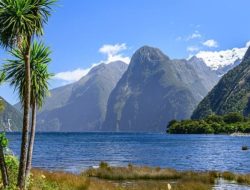Australian Inventions That Changed The World
There are alot of things to discover in Australia. But did you know that you probably have used some Australian inventions and didn’t even know it. Check out these innovative Australian inventions that changed the world:
Check out our most popular vacations that include both Australia & New Zealand!
Australia & New Zealand in 19 days from $3,899
22 Day Australia & New Zealand from $5,399
Black box flight recorder
In 1961 Dave Warren created the black box flight recorder – the device that records voices from the cockpit as well as flight data. The durable boxes were designed to replay the final moments before a plane crash, revealing what went wrong. Today, every commercial plane flies with this Australian invention and the recorder sits in the back of planes, to reduce the chances of damage during a crash.
Contact a Travel Team Agent for more information or to plan your trip at 1-800-788-0829
Spray-on skin
In 1999 Professor Fiona Wood patented her spray-on skin technique. The innovation involves taking a small patch of the victim’s healthy skin and using it to grow new skin cells in a laboratory. The new skin cells are then sprayed on the victim’s damaged skin. This process significantly reduces recovery time and scarring. Fiona and her spray-on skin technique played a key role in treating burns victims from the 2002 Bali bombings. Fiona and her team are credited with saving the lives of 28 people.
Electronic pacemaker
In 1926 Dr Mark Lidwill made an impromptu pacemaker at Sydney’s Crown Street Women’s Hospital. A newborn patient was suffering from heart problems, so Mark connected the baby’s heart to electrodes which stimulated the heartbeat with electric pulses. Concerned about the ethical issues involved with his invention, Mark declined recognition and patents for his invention that has saved many people throughout the world.
Google Maps
From 2003 to 2004 brothers Lars and Jens Rasmussen developed the platform for Google Maps.
Contact a Travel Team Agent for more information or to plan your trip at 1-800-788-0829
Medical application of penicillin
In 1939 Howard Florey, with a team of scientists, purified penicillin from a special strain of mould. The team demonstrated penicillin’s ability to fight bacterial infection in mice and, later, humans. The antibiotic was mass produced and used to aid victims of World War II. Penicillin has been used around the world saving many lives through the combating of infection by common bacteria. Today, it is still widely used in combating infections, but its efficacy is at risk from the growing resistance to the antibiotic.
Polymer bank notes
Plastic bank notes were developed in a combined effort by the Reserve Bank of Australia and CSIRO. The polymer material of the bank notes makes them very durable and counterfeit resistant. The bank notes first circulated in Australia in 1988.
Cochlear implant (bionic ear)
In 1978 Professor Graeme Clark successfully tested the bionic ear. Cochlear implants are devices that are implanted into the head to electronically stimulate the auditory nerve. Graeme’s motivation to advance hearing loss technology was spawned from his father’s inadequate hearing.
Electric drill
In 1889 Australian electrical engineer Arthur James Arnot patented the world’s first electric drill. The invention was originally designed to drill rock and dig coal.
Winged keel
Ben Lexcen, an Australian yachtsman and marine architect, created the winged keel, a nearly horizontal foil, or wing, at the base of a sailing boat keel. They are typically found on high-performance sail boats. The winged keel made its debut in 1983 in America’s Cup on Australia II.
Permaculture
In 1972 Bill Mollison had the epiphany which led to the development of permaculture, a concept that uses a natural approach to designing self-sufficient human settlements and agricultural systems. Today permaculture is an alternative to chemical-based agriculture which can be harmful to humans and the environment
Contact a Travel Team Agent for more information or to plan your trip at 1-800-788-0829
Wi-fi technology
In 1992 John O’ Sullivan and the CSIRO developed wi-fi technology. John and his colleagues were originally looking for black holes when they realised the potential of the technology.
Ultrasound scanner
In 1976 Ausonics commercialised the ultrasound scanner. While studying ultrasound technology, CSIRO’s Ultrasonic Research Centre discovered a way to differentiate ultrasound echoes bouncing off soft tissue in the body and converting them to TV images. This discovery forever changed pre-natal care as it gave expecting parents a window to the foetus without x-ray exposure. Ultrasound technology is also used in the diagnoses of medical problems of the breast, abdomen, and reproductive organs.
Plastic spectacle lenses
In 1960 Sola Optical released the first scratch-resistant plastic lens for glasses. The technology was further developed to create the first plastic bifocal, trifocal, and progressive-focus lenses. Plastic lenses are used throughout the world due to their many benefits including safety, their light weight, and durability.
Inflatable escape slide and raft
In 1965 Jack Grant, of Qantas, invented the inflatable aircraft escape slide, which is now mandatory safety equipment on all major airlines. The slides also can be used as a flotation device if the aircraft lands on water.
Gardasil and Cervarix cancer vaccines
In 2006 Professor Ian Frazer discovered how to create a vaccination for cervical cancer. The commercial application, Gardasil, is a vaccine to prevent certain types of human papillomavirus (HPV). As cervical cancer is the second-leading cause of cancer death in women the vaccination has huge implications for the prevention of cancer.
Frazier lens
In 1993 Jim Frazier’s deep-focus lens was patented in the United States. His innovative lens allowed for both the subject and background to be focused on at the same time. It also has the ability to rotate without the movement of the camera. The lens is now commonly used in movies and film throughout the world. Jim won an Academy Award in 1998 for his contribution.
Ready to plan your dream vacation?
Contact a Travel Team Agent at 1-800-788-0829
Don’t forget to check out our website and Like us on Facebook for the latest travel deals, news & tips!





